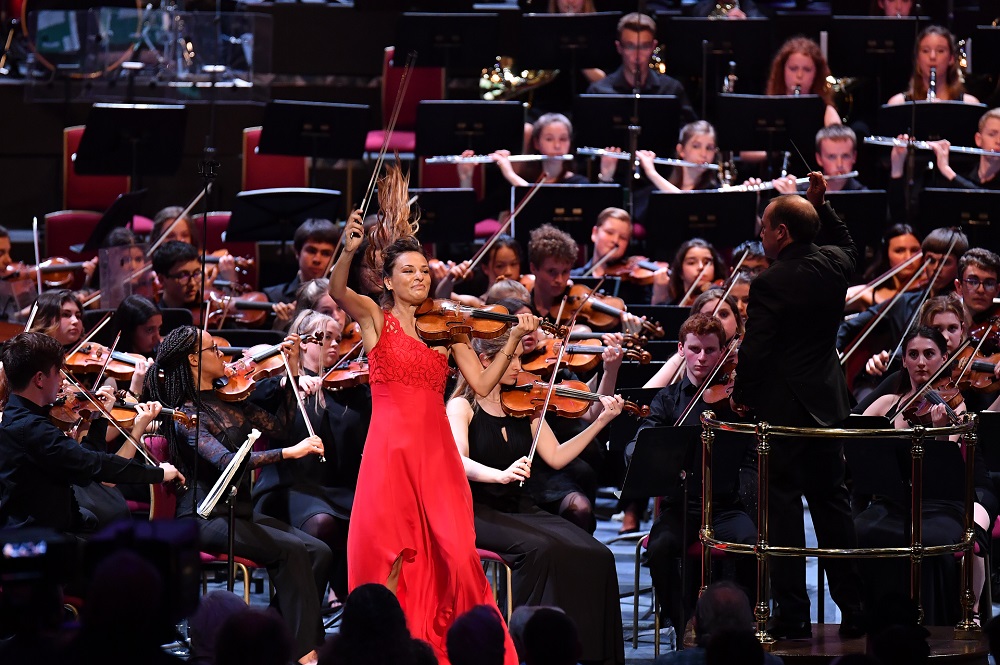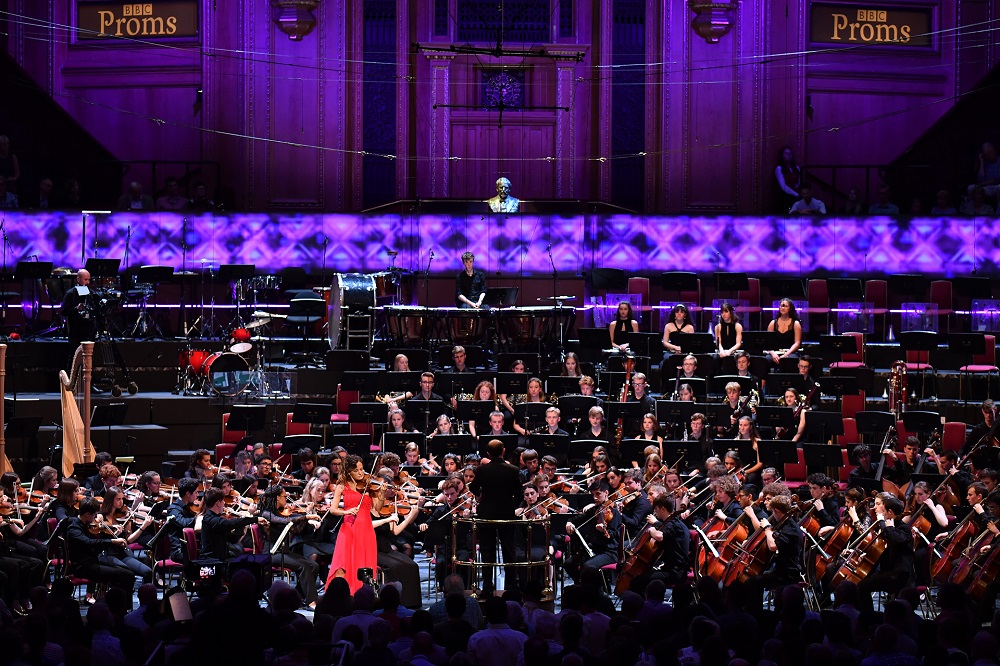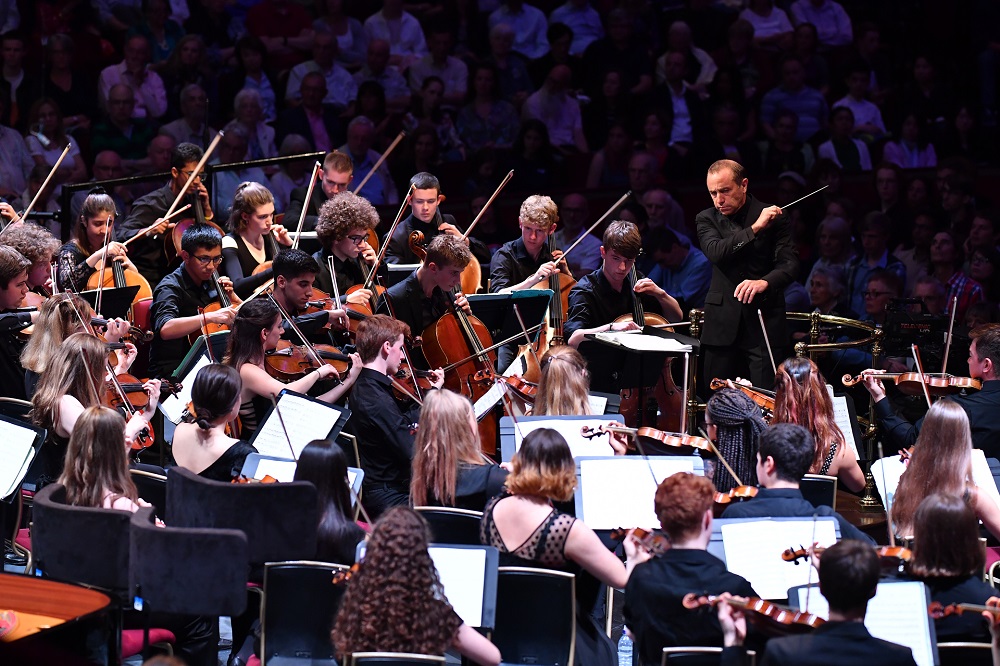Prom 12: Benedetti, National Youth Orchestra of Great Britain, Wigglesworth - adrenalin highs and string sound to die for | reviews, news & interviews
Prom 12: Benedetti, National Youth Orchestra of Great Britain, Wigglesworth - adrenalin highs and string sound to die for
Prom 12: Benedetti, National Youth Orchestra of Great Britain, Wigglesworth - adrenalin highs and string sound to die for
164 teenagers burn for two inspiring mentors in spectacular Russian programme
In the Netherlands, Mark Wigglesworth is already a musical legend for his work with Dutch youth orchestras. Hopefully, in addition to the year and a bit when he wrought miracles at English National Opera, he will become so in the UK after his training of the National Youth Orchestra of Great Britain. That culminated in last night's Prom, with more than a little help from co-inspirer Nicola Benedetti.
By then, the adrenalin and concentration had been flowing through three remarkable interpretations. The start was as visceral as the unofficial finish, wood snapping on strings as Chelyabinsk-born Lera Auerbach’s Icarus flapped wildly in mid-air before biting the dust (“Humum mundere”, as the NYO’s programme but not the Proms’ tells us, is the title of the opening sequence). What refreshment to hear original melodic lines from a contemporary composer; and what a connection to the tragic end of Prokofiev's second-half Shakespearean narrative with the mesmerising final ritual of “Requiem for Icarus”. 
She then gave them and us a treat with the wayward folksy wistfulness of "As the Wind Goes", second movement of the Fiddle Dance Suite written for her by Wynton Marsalis, walking off the platform to infinity at the end (the last time I witnessed that was in the premiere of Matt Kaner’s Stranded at the 2017 Europe Day Concert in St John's Smith Square, when violinist Benjamin Baker's breaking away was a symbolic gesture of the self-harm the UK may still do itself). 
No doubt, though, about the urgency and continuity of the performance. We plunged into the violence of Montagues and Capulets in another suite synthesis before Wigglesworth reverted entirely to the full ballet score, giving us the dance-into-fight sequence from Act One, violins hell-for-leather in combat as if they were the section of the Berlin Philharmonic. 
rating
Share this article
Add comment
The future of Arts Journalism
You can stop theartsdesk.com closing!
We urgently need financing to survive. Our fundraising drive has thus far raised £49,000 but we need to reach £100,000 or we will be forced to close. Please contribute here: https://gofund.me/c3f6033d
And if you can forward this information to anyone who might assist, we’d be grateful.

Subscribe to theartsdesk.com
Thank you for continuing to read our work on theartsdesk.com. For unlimited access to every article in its entirety, including our archive of more than 15,000 pieces, we're asking for £5 per month or £40 per year. We feel it's a very good deal, and hope you do too.
To take a subscription now simply click here.
And if you're looking for that extra gift for a friend or family member, why not treat them to a theartsdesk.com gift subscription?
more Classical music
 Classical CDs: Voice flutes, flugelhorns and froth
Baroque sonatas, English orchestral music and an emotionally-charged vocal recital
Classical CDs: Voice flutes, flugelhorns and froth
Baroque sonatas, English orchestral music and an emotionally-charged vocal recital
 Kanneh-Mason, Britten Sinfonia, Shave, Milton Court - a grin and a big beaming smile
A pair of striking contemporary pieces alongside two old favourites
Kanneh-Mason, Britten Sinfonia, Shave, Milton Court - a grin and a big beaming smile
A pair of striking contemporary pieces alongside two old favourites
 theartsdesk at the New Ross Piano Festival - Finghin Collins’ musical rainbow
From revelatory Bach played with astounding maturity by a 22 year old to four-hand jazz
theartsdesk at the New Ross Piano Festival - Finghin Collins’ musical rainbow
From revelatory Bach played with astounding maturity by a 22 year old to four-hand jazz
 First Person: Manchester Camerata's Head of Artistic Planning Clara Marshall Cawley on questioning the status quo
Five days of free events with all sorts of audiences around Manchester starts tomorrow
First Person: Manchester Camerata's Head of Artistic Planning Clara Marshall Cawley on questioning the status quo
Five days of free events with all sorts of audiences around Manchester starts tomorrow
 Goldscheider, Brother Tree Sound, Kings Place review - music of hope from a young composer
Unusual combination of horn, strings and electronics makes for some intriguing listening
Goldscheider, Brother Tree Sound, Kings Place review - music of hope from a young composer
Unusual combination of horn, strings and electronics makes for some intriguing listening
 theartsdesk Q&A: composer Donghoon Shin on his new concerto for pianist Seong-Jin Cho
Classical music makes its debut at London's K-Music Festival
theartsdesk Q&A: composer Donghoon Shin on his new concerto for pianist Seong-Jin Cho
Classical music makes its debut at London's K-Music Festival
 Helleur-Simcock, Hallé, Wong, Bridgewater Hall, Manchester review - moving lyricism in Elgar’s concerto
Season opener brings lyrical beauty, crisp confidence and a proper Romantic wallow
Helleur-Simcock, Hallé, Wong, Bridgewater Hall, Manchester review - moving lyricism in Elgar’s concerto
Season opener brings lyrical beauty, crisp confidence and a proper Romantic wallow
 Kohout, Spence, Braun, Manchester Camerata, Huth, RNCM, Manchester review - joy, insight, imagination and unanimity
Celebration of the past with stars of the future at the Royal Northern College
Kohout, Spence, Braun, Manchester Camerata, Huth, RNCM, Manchester review - joy, insight, imagination and unanimity
Celebration of the past with stars of the future at the Royal Northern College
 Jansen, LSO, Pappano, Barbican review - profound and bracing emotional workouts
Great soloist, conductor and orchestra take Britten and Shostakovich to the edge
Jansen, LSO, Pappano, Barbican review - profound and bracing emotional workouts
Great soloist, conductor and orchestra take Britten and Shostakovich to the edge
 Jakub Hrůša and Friends in Concert, Royal Opera review - fleshcreep in two uneven halves
Bartók kept short, and a sprawling Dvořák choral ballad done as well as it could be
Jakub Hrůša and Friends in Concert, Royal Opera review - fleshcreep in two uneven halves
Bartók kept short, and a sprawling Dvořák choral ballad done as well as it could be
 Hadelich, BBC Philharmonic, Storgårds, Bridgewater Hall, Manchester review - youth, fate and pain
Prokofiev in the hands of a fine violinist has surely never sounded better
Hadelich, BBC Philharmonic, Storgårds, Bridgewater Hall, Manchester review - youth, fate and pain
Prokofiev in the hands of a fine violinist has surely never sounded better

Comments
I listened to the broadcast
Strictly speaking, yes, the
Strictly speaking, yes, the Knights' Dance appears in the Capulet ball. But in one of the suites, preceded by 'the Duke's Command', it is called 'Montagues and Capulets' and stands for the violence between the clans, which is why Wigglesworth chose it as the starter. So, this time loosely speaking, he did 'stick to the plot'. And there was no 'chunk of it there (up to Juliet's solo)' - that was all fight music from Act One.
Even though the first page of
Now you're being pedantic,
Now you're being pedantic, and if one is pedantic in return, you're wrong. The version Wigglesworth used was the movement from the suite (the orchestrataion is different). Both the fact that he chose to begin with it and the faster tempo he took, which you didn't like and which I would argue conveys a more general violence than the striding of 'Dance of the Knights' in the ballet, points to his intention to give the love story the turbulent context of warring clans.
You have certainly confirmed
Hardly challenged. I reasoned
Hardly challenged. I reasoned, you ignored. There are certain facts which can't be denied. Though I granted initially that, strictly speaking, there was some music from the Capulet ball.